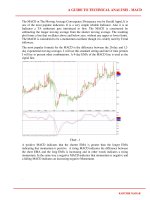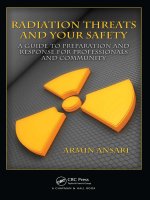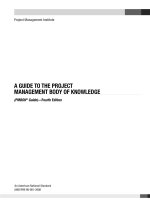a guide to technical presentations
Bạn đang xem bản rút gọn của tài liệu. Xem và tải ngay bản đầy đủ của tài liệu tại đây (1.03 MB, 38 trang )
A Guide to
Technical
Presentations
Electrical and Computer Engineering
Department
CLEAR Engineering Oral Consultant Damon Hall
Adapted from: Anne Robertson, University of Utah
Technical Presentations DH 2005
The Three Most Important
Elements of a Technical
Presentation
•
Organization
•
Visual Aids
•
Delivery and Style: Your Presence and
Preparation
Technical Presentations DH 2005
Before You Present…
Technical Presentations DH 2005
Identify the Purpose
•
What is your general purpose?
•
What is your specific purpose?
•
What is your thesis statement?
•
What do you want your audience to learn?
•
What action should be taken next?
Technical Presentations DH 2005
Perform an Audience Analysis
•
Identify who your audience will be
•
Identify your objectives for the audience
•
Identify their understanding of the subject
•
Determine how willing they will be to accept
your ideas
Technical Presentations DH 2005
Organization
Technical Presentations DH 2005
Organization: Introduction
•
Identify who you are/establish your
“presence”
•
Why should they listen to YOU? Express your qualifications,
passions, become a bit “human” to the audience
•
Earn the audience’s attention
•
What will they get from listening to you?
•
Why should they listen?
•
Give a roadmap: Tell ‘em what you’re gonna
tell ‘em
•
Explain where you plan to go, set up the story
•
Explain what the audience can anticipate
Technical Presentations DH 2005
Organization: Introduction cont.
•
Don’t say “Before I begin”
•
Don’t apologize for being nervous
•
Don’t read the introduction
•
Don’t use a dramatic, irrelevant opener
•
Don’t make the introduction too long
Technical Presentations DH 2005
Organization: Body
Create main points to express key ideas
and major claims
•
Present points as declarative statements
•
Reflect points back to thesis
•
Keep speech points unified, coherent,
and balanced
•
Verbalize connections between points
Technical Presentations DH 2005
Organization: Transitions
•
A word or phrase that signals when a speaker has
finished one thought and is moving onto another
These are the turn signals necessary for changing
lanes.
•
2 parts to a transition: Transitions state the idea
that the speaker is leaving (the review part) and
the idea that the speaker is coming up to (the
preview part)
Ex: Now that you know what the TPS report is
(review), I will discuss its functions (preview).
Technical Presentations DH 2005
Organization: Conclusion
•
Purpose: Tell ‘em what you told ‘em
•
Offers audience a sense of closure
•
Reinforces thesis
•
Tips
•
Signal the end verbally and non-verbally
•
Restate the thesis using a strong
concluding statement
•
Make conclusions strong and brief
Technical Presentations DH 2005
Organization: Conclusion
cont.
•
Don’t drag out the conclusion
•
Don’t end on a weak or rambling note
•
Don’t introduce new points
•
Don’t say “so in conclusion”
•
Don’t end with “Any Questions?” (if the
audience was engaged, then they will have
questions)
Technical Presentations DH 2005
Visual Aids
Technical Presentations DH 2005
Fonts Are Important!
•
Use Microsoft sans
serif fonts
•
Use readable font
sizes
•
Use appropriate color
combinations
40 point Title
28 point Heading
24 point Sub-headings
18 point References and Labels
Avoid using 12 point font or smaller
Technical Presentations DH 2005
Fonts Will Make or Break a
Presentation
•
Use sans serif fonts
•
Use readable font
sizes
•
Use appropriate color
combinations
40 point Title
28 point Heading
24 point Sub headings
18 point References and Labels
Avoid using 12 point font or smaller
Technical Presentations DH 2005
Make Sure You’re Grammar is Correct
•
Affect v. Effect
Affect (verb) influence or change
Effect (verb) bring about or (noun) result
•
Whose v. Who’s
Whose means belonging to whom
Who’s is a contraction of who is
•
Your v. You’re
Your is possessive
You’re is a contraction of you are
•
Its v. It’s
Its is a pronoun indicating possession
It’s is a contraction of it is
Technical Presentations DH 2005
PowerPoint Slide Layout
Title
Identification
Fonts and font
color match
Bullet Points
line up
Informative—
but not too
much detail
Technical Presentations DH 2005
The Abuses of Capital Letters
•
Bullet points typically have one capital
letter at the beginning
•
Just because You think a word is Important
does Not mean it should be Capitalized
•
ALL CAPITAL LETTERS MAKE IT HARDER
FOR YOUR AUDIENCE TO DECIPHER
WORDS
Technical Presentations DH 2005
The Exclamation Point
Don’t over use this. Be careful of when
and where you use it.
!
!
!
Warning!
Technical Presentations DH 2005
Avoid Using Too Many Words
•
Use Bullet Points
•
Use Condensed Sentences
•
No parking structure will be considered if the
cost per stall to erect the structure is greater
than $11,000.
•
Parking structures will cost less than $11,000
Technical Presentations DH 2005
The Infamous Laser Pointer
Technical Presentations DH 2005
•
Practice with the laser pointer.
•
Use sparingly: Only when necessary
Visual Aids Do’s and Don’ts
Do’s
•
Design them large
enough
•
Design them to be
simple
•
Deign them to be clear
•
Label them
•
Use only what you
need
Don’ts
•
Use too much text
•
Use excessive
artwork
•
Make things look
cramped
•
Use too many colors
•
Overuse caps
Technical Presentations DH 2005
Referencing Sources
Figure 1: The cost analysis for the alternatives in the structural teams
analysis
Smith (2002). Engineering Your Future Cambridge, New York
Reference…
Quotes Figures Facts
Statistics Codes Charts
Graphs Pictures
Examples
Technical Presentations DH 2005
Delivery
Technical Presentations DH 2005
Good Delivery…
•
Is clearly audible, fresh, and energetic
sounding
•
Is a polished version of yourself
•
Looks and sounds natural
•
Is human, not robotic or like a TV news
anchor
•
Has controlled and planned body movements
•
Is extemporaneous (don’t read slides!)
•
Is always focused on the goal (speak so your
audience will understand)









![cruising alaska [electronic resource] a guide to the ports of call.](https://media.store123doc.com/images/document/14/y/ba/medium_bal1401351374.jpg)